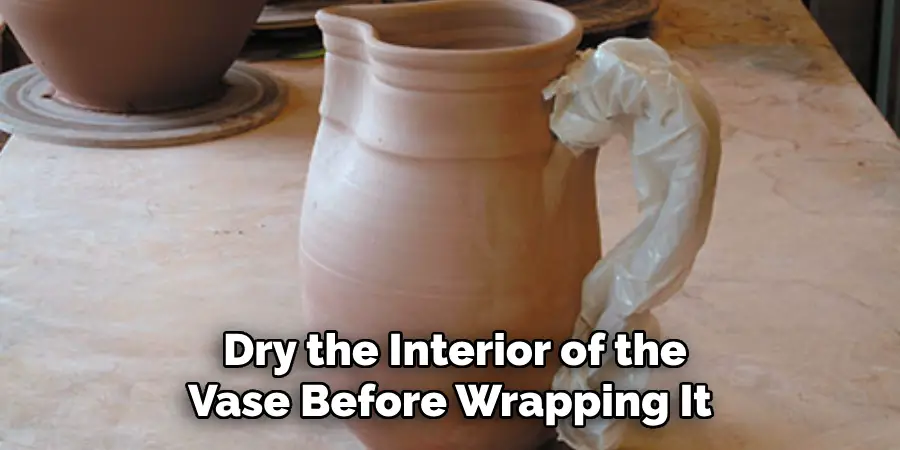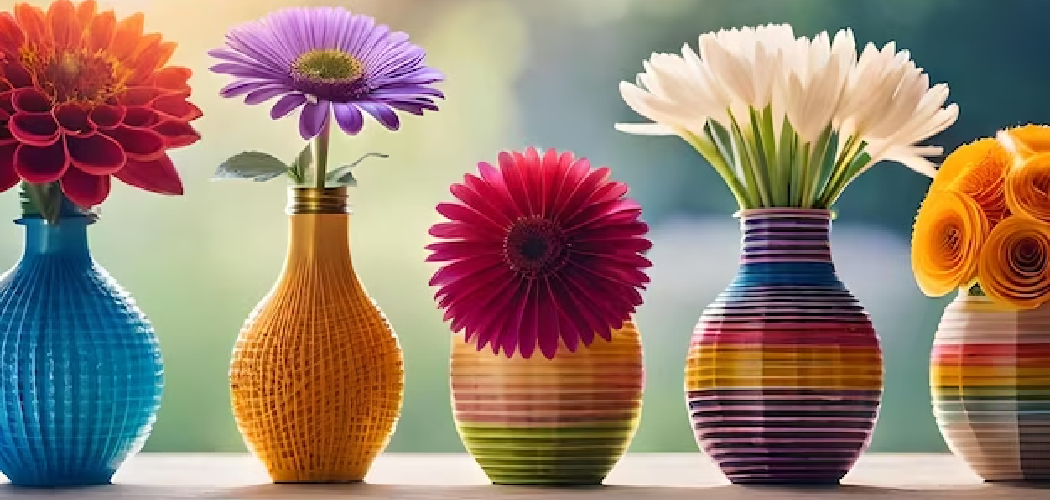Wrapping a vase is an essential skill to have, especially if you are planning to gift or transport one. Properly wrapping a vase ensures that it stays safe and intact during the transportation process. Without proper wrapping, your vase may get damaged, leading to disappointment and additional costs.

The main advantage of wrapping a vase is the ability to protect delicate items during transportation or storage. Vases are often made of fragile materials such as glass or ceramic, and learning how to properly wrap them can prevent damage and save you from having to replace expensive items. In this blog post, You will learn in detail how to wrap a vase.
Step-by-step Instructions for How to Wrap a Vase
Step 1: Inspect the Vase
Before wrapping a vase, carefully inspect it for any cracks or chips. These can make the vase more fragile and may require additional care when wrapping. To wrap a vase, you will need bubble wrap, packing paper, tape, scissors, and a sturdy box that is slightly larger than the size of your vase.
Step 2: Prepare the Vase
Remove any water or debris from the vase and dry it thoroughly. If the vase has a lid or removable parts, carefully remove them and wrap them separately. Start by wrapping the base of the vase with a layer of bubble wrap, making sure to cover all sides. Secure with tape to keep it in place.
Step 3: Wrap the Neck of the Vase
Next, wrap the neck of the vase with a layer of bubble wrap, overlapping it slightly with the base wrap. Use tape to secure it in place. After wrapping the vase with bubble wrap, add a layer of packing paper over it. This will provide an extra layer of protection against any bumps or scratches.

Step 4: Wrap the Entire Vase
Continue wrapping the vase with additional layers of bubble wrap and packing paper until it is completely covered. Make sure there are no exposed areas. Use tape to secure all layers of bubble wrap and packing paper in place. This will prevent them from shifting during transport.
Step 5: Place the Vase in a Box
Carefully place the wrapped vase into a sturdy box, making sure there is enough room for additional packing materials around it. Fill any empty spaces in the box with packing peanuts or crumpled paper to provide extra cushioning and prevent movement during transport.
Step 6: Seal the Box
Close and seal the box with tape, making sure all sides are secure. Label the box as fragile and mark it with arrows indicating which side should be facing up. Your vase is now ready to be transported or stored safely. Be gentle when handling it and always keep it in an upright position to prevent any damage.

Safety Tips for How to Wrap a Vase
- Always wear gloves when handling delicate items like vases to avoid accidental slips or breakages.
- When wrapping a vase, make sure the surface you are working on is clean and free from any debris or sharp objects that may scratch or damage the vase.
- Use an appropriate sized box for your vase. Avoid using boxes that are too big as they can lead to the vase moving around and potentially getting damaged during transportation.
- Use bubble wrap or packing paper to create a protective layer around the vase. Make sure you cover all the vulnerable parts of the vase, such as handles or spouts.
- Securely tape the dubble wrap or packing paper in place to ensure it doesn’t move during transportation. This will also prevent any external factors from damaging the vase.
- Label the box with fragile stickers and add directional arrows to indicate which way is up. This will ensure proper handling of the box and prevent any accidental drops or mishandling.
- If you are shipping the vase, choose a reliable courier service that offers insurance for delicate items. This will provide extra protection in case of any accidents during transportation.
By following these safety tips, you can ensure that your vase arrives safely at its destination without any damages. Don’t take any risks when it comes to delicate items like vases, as they can hold sentimental or monetary value.
Why is It Important to Wrap a Vase Before Storing or Transporting It?
Wrapping a vase before storing or transporting it is important for several reasons. Firstly, vases are delicate items and can easily get damaged if not handled with care. By wrapping them, you provide a layer of protection that minimizes the risk of any accidental drops or impacts.
Secondly, vases often have intricate designs and patterns that can be easily scratched or damaged during transportation. By wrapping them with bubble wrap or packing paper, you create a barrier that prevents any external factors from damaging the vase.

Thirdly, if you are storing or transporting multiple items at once, wrapping each vase individually will prevent them from rubbing against each other and potentially causing damage. Lastly, by labeling the box with fragile stickers and directional arrows, you ensure that everyone handling the box knows to handle it with care and which way is up. This reduces the risk of any mishandling or accidents during transportation.
Is There a Specific Technique for Wrapping Vases With Handles or Spouts?
Whether you’re packing up your vases for a move or shipping them to a loved one, it’s important to know how to properly wrap them to ensure they arrive safely at their destination. While there are many different techniques for wrapping vases, some may be better suited for certain types of vases than others.
When it comes to vases with handles or spouts, there is no one-size-fits-all technique. The best approach will depend on the shape and size of your vase as well as the material it is made from. However, there are some general tips that can help you properly wrap any type of vase with handles or spouts.
First and foremost, it’s important to use high-quality wrapping materials such as bubble wrap or packing paper. These materials provide cushioning and protection for your vase during transit. Avoid using newspaper or tissue paper as they are not sturdy enough to protect your fragile vase. Next, consider the shape of your vase. If it is a tall and narrow shape with handles, you may want to use an “H” style wrapping technique. This involves wrapping the handle separately from the rest of the vase and then wrapping the body of the vase, creating an “H” shape. This method can provide extra protection for the handles and prevent them from breaking during transport.
Should You Remove Any Water From the Vase Before Wrapping It?
When it comes to wrapping a vase, one question that often arises is whether or not you should remove any water from the vase before wrapping it. The answer to this question depends on a few factors. If the vase will be transported over a long distance, then removing the water may be necessary in order to prevent spills and leaks during transit.
This is especially important if the vase is fragile or has a narrow neck. In this case, it is best to pour the water out and dry the interior of the vase before wrapping it.

On the other hand, if you are only moving the vase a short distance, such as from one room to another in your home, then leaving the water in may not be an issue. However, be sure to handle the vase carefully and keep it upright to avoid any spills.
If you are wrapping the vase for storage purposes, then it is generally recommended to remove any water from the vase. This will prevent the growth of bacteria or mold inside the vase while it is in storage.
Are There Specific Methods for Wrapping Different Types of Vases (I.e. Ceramic, Glass, Porcelain)?
The short answer is yes. Just like with any other fragile item, different types of vases may require specific methods for wrapping in order to ensure their safe transport or storage. Here are some tips for wrapping different types of vases:
1. Ceramic Vases
These vases can be wrapped in bubble wrap or packing paper and placed inside a sturdy box with enough cushioning material around it to prevent any movement.
2. Glass Vases
These vases are best wrapped with several layers of bubble wrap or foam. You can also use cardboard dividers between multiple vases to protect them from rubbing against each other.
3. Porcelain Vases
Similar to glass vases, porcelain vases should also be wrapped in multiple layers of bubble wrap or foam. However, be extra careful with any delicate details or handles on the vase.
It is also important to make sure that the wrapping materials are secured in place and there is enough cushioning inside the box to prevent any movement during transport or storage. Do not stack heavy items on top of vases while they are wrapped as this can cause damage.
Conclusion
In conclusion, learning how to properly wrap a vase is an essential skill for any flower enthusiast or gift-giver. It not only ensures the safe transport of delicate vases, but also adds a touch of personalization and thoughtfulness to any gift.
Remember to always start with a clean and sturdy surface, use plenty of cushioning material, secure the vase with tape or rubber bands, and finish off with a layer of wrapping paper or fabric.Additionally, you can get creative with your wrapping materials and add decorative elements such as ribbons or bows for an extra special touch.
Not only will this make your gift stand out, but it will also show the recipient that you put effort and care into their gift. I hope this article has been beneficial for learning how to wrap a vase. Make Sure the precautionary measures are followed chronologically.

